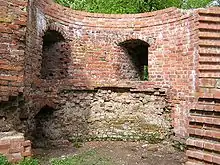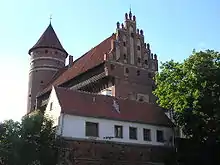Siege of Allenstein
The Siege of Allenstein or the Siege of Olsztyn took place from January 1521 to February 1521, during the Polish–Teutonic War (1519–21).
- You may also be looking for the Battle of Allenstein.
| Siege of Olsztyn (Allenstein) | |||||||
|---|---|---|---|---|---|---|---|
| Part of the Polish–Teutonic War (1519–21) | |||||||
 Warmia (Ermeland) surrounded by the Duchy of Prussia founded in 1525 | |||||||
| |||||||
| Belligerents | |||||||
| Kingdom of Poland |
| ||||||
| Commanders and leaders | |||||||
| Nicolaus Copernicus[2] | Wilhelm von Schaumber[3] | ||||||
| Strength | |||||||
| 200 infantry, several hundred dismounted cavalry[3] | 400 infantry, 600 heavy cavalry, 400 light cavalry[3] | ||||||
| Casualties and losses | |||||||
| unknown | unknown | ||||||

The town of Olsztyn (Allenstein) was defended by Polish forces against those of the German Monastic Order of the Teutonic Knights. The defense of the town was successfully organized and coordinated by Polish astronomer and scholar Nicolaus Copernicus.[2][4] The Poles successfully resisted the German knights, who eventually had to lift the siege.[1] By the end of 1521 the Teutonic Knights were forced to ask for an armistice and in 1525 the Grand Master of the Order, Albrecht Hohenzollern, paid homage to the Polish king, Sigismund the Old.[5]
Background
In the 13th century, during the Northern Crusades, the region of the pagan old Prussians had been conquered by the Monastic Order of the Teutonic Knights. In the 15th century, due to discontent with the Order's conduct, the Prussians revolted against them. In the Second Peace of Thorn, Royal Prussia became part of the Kingdom of Poland, although with special local privileges. Royal Prussia included the Prince-Bishopric of Warmia (Ermeland), which was surrounded on three sides by the Monastic state.[6]
The Polish astronomer Nicolaus Copernicus, who was also a canon (clerical administrator), had been an administrator at Allenstein (Olsztyn) from 1516 to 1519[3] and was a "mainstay of resistance" to the Teutonic Knights there.[5] In 1519, he left for Frombork (German: Frauenburg).
In 1511, Albrecht Hohenzollern became the Grand Master of the Teutonic Order. Like some of the previous Masters, he tried to avoid having to pay homage to the King of Poland of whom he was a vassal. As a result, in 1519 war broke out between the Teutonic Knights and the Kingdom of Poland, with the region of Warmia as a major scene of conflict.[3]
Teutonic Order troops invaded Warmia in December 1519 with around 5,000 soldiers.[1] In January 1520, they besieged Frauenburg, and eventually burned the whole town, including the houses of the canons (clerical administrators of Warmia) and that of Copernicus.[1] The late arrival of Polish troops saved the town's cathedral from destruction.[7] As a result, Copernicus was forced to move to Olsztyn where he was put in charge of organizing the defense of the city against the expected attack. He improved the fortifications and stockpiled food and supplies,[5] in the hope that the city could hold out long enough for reinforcements from the King of Poland to arrive. He sent letters to the Polish king asking for extra soldiers to strengthen the 100-man garrison.[7]
As a further precaution, he also sent letters to Elbląg (Elbing) with a request for additional supplies and 20 cannons.[7] The letter to the Polish king was intercepted by the knights. Sigismund, however, learned of the threat through other channels[3] and the garrison of the town was expanded to 200 when a unit of infantry, under the leadership of the Czech commander Henryk Peryk of Janowice arrived.[3] Another 700 cavalry under Rotmistrz Zbigniew Slupecki showed up soon after.[3] Further supplies from Elbing, consisting of lead, salt, and 16 more artillery pieces arrived in early February.[3]
Siege


The Knights arrived at Allenstein on January 16, 1521, with a force of some 400 infantry, 600 heavy cavalry, 400 light cavalry, and artillery.[3] They were met by small skirmish units whose purpose was to delay the Knights' attack for as long as possible.[1][3] The Teutonic Knights demanded that the town surrender, hoping that a show of force would suffice. Copernicus, however, refused to accede to the demand.[1]
On January 26 the Knights launched their assault on the town, led by Wilhelm von Schaumber, near the Brama Młyńska (Mill Gate).[3] The Knights managed to approach the walls across the frozen moat and broke through the gate.[3] They hoped to surprise the town's defenders.[3] An alarm was sounded, however, and Polish soldiers rushed to the breach in the gate. According to Jerzy Sikorski (a Polish historian who played a large part in locating Copernicus’ grave), Copernicus probably came out onto the walls and personally directed the Polish defense of the town.[3] The attack was repulsed, and the Teutonic Knights’ assault force was forced to withdraw.[3]
Aftermath

By the end of February, with the arrival of additional reinforcements from Elbląg, the Teutonic Knights were forced to abandon their siege.[1] By the end of 1521, due to lack of funds to continue the war, and the threat of a large Polish army approaching, they were forced to negotiate with the Polish King.[1] Copernicus represented the Polish side in the armistice negotiations.
This was the last time that the Teutonic Knights invaded Warmia.[1]
The war ended in 1525, and on April 10 of that year Albrecht Hohenzollern, now converted to Lutheranism, paid homage to Polish King Sigismund I as a vassal,[5] in what has become known as "the Prussian Homage."[8] According to the Treaty of Kraków, in return, Albrecht received the eastern portion of Prussia, which became known as Ducal Prussia, in fief from Poland, as a secular duchy, while the western portion, Royal Prussia, together with Warmia, remained under the Polish crown.[9]
References
- Jack Repcheck, "Copernicus' Secret: How the Scientific Revolution Began", Simon and Schuster, 2008, pg. 66,
- Jerzy Jan Lerski, Piotr Wróbel, Richard J. Kozicki, "Historical dictionary of Poland, 966-1945", Greenwood Publishing Group, 1996, pg. 403,
- Tomasz Kurs, "Jak Kopernik obronił Olsztyn przed Krzyżakami" (How Copernicus defended Allenstein against the Teutonic Knights), Gazeta Wyborcza, 2008-07-30,
- Marcus Hellyer, "The scientific revolution: the essential readings", Wiley-Blackwell, 2003, pg. 47,
- Patrick Moore, "The Great Astronomical Revolution: 1534-1687 and the Space Age Epilogue", Horwood Publishing, 1994, pg. 68-70,
- Jerzy Lukowski; Hubert Zawadzki (20 September 2001). A Concise History of Poland. Cambridge University Press. p. 39. ISBN 978-0-521-55917-1. Retrieved 31 May 2012.
- Owen Gingerich, James H. MacLachlan, "Nicolaus Copernicus: making the Earth a planet", Oxford University Press US, 2005, pg. 88-90,
- Karin Friedrich (24 February 2000). The Other Prussia: Royal Prussia, Poland and Liberty, 1569-1772. Cambridge University Press. p. 150. ISBN 978-0-521-58335-0. Retrieved 31 May 2012.
- Jerzy Lukowski; Hubert Zawadzki (20 September 2001). A Concise History of Poland. Cambridge University Press. pp. 41–. ISBN 978-0-521-55917-1. Retrieved 31 May 2012.